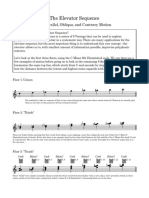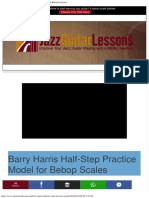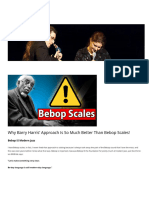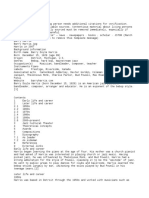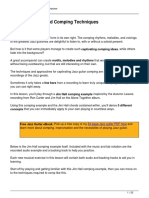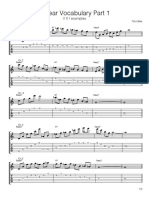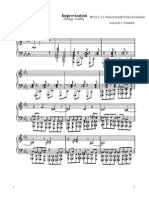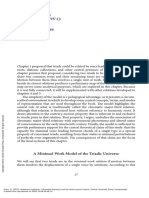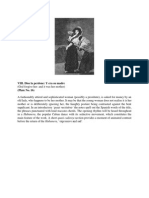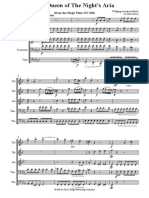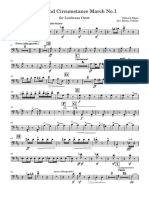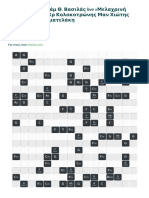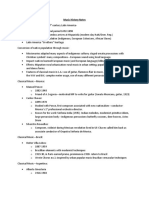Foundations: Towards a New Chromatic Theory
Volume 0 — Introduction and Overview
by
Dr. Thomas Echols
1
� Foundations 0
Welcome to the Labyrinth
We’ve all heard that foundations are important.
After almost 4 years of the Labyrinth of Limitations project, I’ve decided it’s Cº
time to revisit these foundations. This new series is where I will share a cohe- F7
sive, well-organized approach to daily practice that will guide you from the D7 Ab7
beginning stages to improvisational fluency using Barry Harris’s concepts. B7
Just after completing my Doctor of Musical Arts degree at the University of
Southern California in 2010, I discovered Barry Harris’s wonderful teachings, DMaj6
D7b5 B7b5
BMaj6 AbMaj6
and this has taken me on an incredibly rewarding journey that, I assume, will FMaj6
continue for the rest of my life. My ongoing collaboration with Chris Parks
(of Things I Learned from Barry Harris) has been one of the most rewarding Bmin6
Dmin6 Abmin6
of my musical life, having regularly met with him to explore these ideas to- Fmin6
gether over the past four years since we became friends. All of this is to say
that there is a lot of thought and care that has gone into this Foundations Bº
project, and hope that you will find it as rewarding as I have.
E7
Db7 G7
Below, you will find a few sample pages from each of the first 3 volumes of Bb7
this series. There is also a page about the Labyrinth App. Foundations I-VII
will essentially be a version of the textbook that I have had in mind for many Db7b5 Bb7b5
DbMaj6
years, and the App will be an important part of this, with lesson files provided EMaj6
BbMaj6 GMaj6
that will allow you to interact with many of the materials being discussed;
changing static scores and chord diagrams into something more organic and Bbmin6
exploratory. Dbmin6
Emin6
Gmin6
If you’ve purchased my PDFs before, I hope that you will find these new Bbº
documents to be of a much higher quality. In order to effectively share the
fundamental ideas on which the curriculum of the Labyrinth of Limitations Eb7
is built, I’ve developed a lot of graphics and charts that, I hope, you will find C7 Gb7
A7
helpful.
C7b5 A7b5
On the next page, you will find the Structure of the Curriculum. It will be EbMaj6
CMaj6 AMaj6 GbMaj6
most effective to take this as we go, explaining and demonstrating the mean-
ing of each part as it comes up in the Foundations series. Amin6
Cmin6 Gbmin6
Ebmin6
I’ve developed a 7-part practice routine for Polyphony and for Monophony,
which will be discussed in Foundations I and II respectively. Foundations Aº
2
�III-VI will dive into the Four Important Questions and how we can apply them in our practice. Foundations VII
will discuss methods of “interpreting” immediately, in a musically expressive way, the music that we improvise (so
that it “speaks”).
The 5 Aspects of practice will be discussed throughout this curriculum. They are principles that can help us to
further focus our creativity and have productive practice.
The 3 Phases of practice represent the progression from curiosity to mastery. These phases will be discussed
throughout the curriculum as well.
What we want to achieve is Linguistic Muscle Memory. This means that we don’t want to just have a series of pretty
phrases and “licks” that we can switch between. Rather, we want to be able to intermingle cellular ideas freely, cre-
ating endless sonic fabrics, gestures, polyphonic improvisations and beautiful lines. Fortunately, Barry Harris gave
us the materials that we need in order to acquire LMM.
It’s all about the small things, and I believe I have developed a clear method for you to join me in exploring these
little things in a methodical way, allowing you to experience continual growth. I hope that this will be a grounding
experience that provides a renewed sense of direction to your practice.
About my Approach
There are some things that you will find new and unusual within the Labyrinth of Limitaitons course of study. Most
notably, I use musical geometric concepts taken from the work of Dmitri Tymoczko to clarify relationships among
the various chords we use for polyphonic improvisation. I have also employed new terminology and
theoretical frameworks that I have independently developed, being careful not to “reinvent the wheel” but,
rather, to only do this when there isn’t a readily-available, succinct term for any given structure or concept. I
mention Barry Harris throughout the Labyrinth of Limitations, because it is often the case that there is only one
source of a particular theoretical formulation —the frameworks that he taught to his students through informal
group classes. I like to think of myself as a post-Harrisian scholar and musican, and citing Barry’s important and
necessary body of work is a way of acknowledging this.
For more information about Barry Harris, including a biography and discography:
https://www.barryharris.com
For the Foundations 0 YouTube episode, click here
3
� Structure of the Curriculum
The Chromatic Scale Runs
Transformation Transformation
Substitution Linear Chords
Relative Motion Important Arpeggios
Borrowing The Chromatic Scale
Summoning Objects Half-Step Rules
Finding Paths The ABC’s
Polyphonic Practice Intertwining Monophonic Practice
Interpretation: Making it Speak
Envisioning: Possibilities of Movement 4. Which [z] movements are within a given tune?
Mastery (Musical Applications within a Tune) Recognition: Seeing What is Present 3. What contexts contain [z] movements?
Embodied Knowledge (Building Technique) Summoning: Bringing Forth a Structure 2. Where can I summon [y] object?
Discovery (Finding Real Questions) Finding Paths: Measuring Distance Within Structures 1. What can I do to [x] pitch?”
3 Phases of Practice 5 Aspects of Practice 4 Questions
4
©Thomas Echols
� Foundations Series Overview
Foundations 0: Introduction and Overview
Foundations I: Polyphonic Improvisation
Foundations II: Monophonic Improvisation
Foundations III: What can I do with [x] pitch?
Foundations IV: Where can I summon [y] object?
Foundations V: What contexts contain [z] movements?
Foundations VI: Which [z] movements are in a given tune?
Foundations VII: Interpretation - Making it Speak
5
� The Labyrinth of Limitations App
I designed and developed the Labyrinth of Limitations App to help people learn the fundamentals of Barry Harris’s har-
monic concepts. When you subscribe to the app, you can import playlists of songs and lesson files that will help you to free-
ly explore the material shared in Foundations I: Polyphony. There is a download link for the lesson file in the Foundations
I pdf, which you can then import through the Repertoire Menu in the app.
Future iterations will include monophonic, single line soloing in addition to even more options on the polyphonic side of
things.
At this time, the App is only available for Mac and Windows computers.
6
©Thomas Echols
�A Sample from Foundations I: Polyphony
The following is an excerpt taken from Foundation I. We work through the material in a step-by-step manner;
keeping things simple and making beautiful music as we go. This is the end of one such sequence, working out
some concepts over a jazz standard.
vi ii m7b5
I V7/V
Minor 6
V7
ugliest duckling iv
ii7 V7 I (ii-V7) V7 V7
Abmin6=Tritone’s Minor Abmin6=Tritone’s Minor
tritone’s minor minor 6 on the 5
Here is our complete phrase for the first 8 bars of Take the “A” Train. Keep in mind that we’re intentionally trying to
isolate the Substitution aspect of things while still practicing and developing intelligent muscle memory of the concepts.
Our progress will be clear if we can continue to separate things (and then put them together). First, we’ll play the
phrase starting from a root position C6 chord.
C6 Am6 Cdim7
F6 A m6 C6 A m6
Substitution Ex. 4. Playing the Tritone’s Minor.
On the next two pages, you will find diagrams that help to illustrate the narrative of Foundations I. This is from
the Theory section (the work is divided in two parts: theory and practice). I hope that these samples serve to pique
your interest about what’s to come! You can purchase Foundations I: Polyphony here.
7
©Thomas Echols
�A Family of Major 6 Chords
From Two Diminished Chords C#º
F#7
Eb7 A7
C7
C C
B C#/Db B C#/Db F#Maj6
EbMaj6 CMaj6 AMaj6
A#/Bb D A#/Bb D
A
2 D#/Eb A
2 D#/Eb
G#/Ab E G#/Ab E
G F G F
F#/Gb F#/Gb
Primary Parent Secondary Parent
C C C C
B C#/Db B C#/Db B C#/Db B C#/Db
A#/Bb D A#/Bb D A#/Bb D A#/Bb D
A D#/Eb A D#/Eb A D#/Eb A D#/Eb
G#/Ab E G#/Ab E G#/Ab E G#/Ab E
G F G F G F G F
F#/Gb F#/Gb F#/Gb F#/Gb
C Major 6 A Major 6 F# Major 6 Eb Major 6
Figure 2. Lower (or raise) two adjacent notes from a diminished chord to create a Major 6 chord.
8
©Thomas Echols
�The Major 6
Diminished Scale
Primary Parent Secondary Parent
C C
B C#/Db B C#/Db
A#/Bb D A#/Bb D
A
2 D#/Eb A
G#/Ab
2 D#/Eb
G#/Ab E E
G F G F
F#/Gb F#/Gb
C Major 6 The Unrelated Diminished Chord
C
C B C#/Db
B C#/Db
A#/Bb D
A#/Bb D
A D#/Eb
A D#/Eb
G#/Ab E
G#/Ab E
G F
G F F#/Gb
F#/Gb
Figure 3. C Major 6 is interleaved with the unrelated diminished chord (AKA the “off” chord) to create the C Major 6 Diminished Scale
C
B C#/Db
A#/Bb D
A D#/Eb
G#/Ab E
G F
F#/Gb
While the C Major 6 Diminished scale has special properties, it is still a scale and should be treated as such. Start by
practicing it note by note. 9
©Thomas Echols
�A Sample from Foundations II: Monophony
Here is the table of contents for Foundations II, followed by an excerpt showing part of the “inner game” of this improvisational practice. You can
purchase Foundations II: Monophony here.
10
©Thomas Echols
� [exerpt from Foundations II: Monophony]
Summoning
This diagram depicts the internal process of summoning. The Labyrinth curriculum has layers of frameworks that
we learn in order to gain improvisational fluency, but the deepest concept, the thing that gives the real cohesion
behind everything, is that summoning and pathfinding are the fundamental background activities. These aspects
of our work are always present.
Pathfinding is the question, “Where is the next scale degree?”
Summoning is the questions, “What can I do to that scale degree?”
For example, I could use my pathfinding to move from the 7th to the 3rd of the G7 scale. . .
Then I could summon from an array of modules that I have at my command. Here are some possible choices.
Up a third
3r
d
an
d
rd
ha
ho
lf-
ac
st
ep
Up
ru
le
Half Step, Down a chord Chromatic
Do
Half Step Rule
w
n
t
vo
ac
Pi
ho
rd
Theory Example 24: A few of the choices we can summon for the 3rd degree of the G Dominant 7 scale. These modules are fully ex-
plained in the practice section of this document.
11
©Thomas Echols
� [exerpt from Foundations III: What Can I Do With [x] Pitch?]
multicursal
1. (something figurative) Of a maze or labyrinth: having more than one possible route between
the centre and the outside.
2. (in musical improvisation) A graphical representation of the divergent paths that are available
from any given point in a musical improvisation.
This volume makes use of labyrinthine charts that show multiple possibilities for creating a line.
The purpose of these is to help you get inside the “inner game” of real-time improvisation.
Take a quick look at page 38. You will find an array of choices that all revolve around the A-nat-
ural note that is played on the 5th fret of the 1st string, situated within the “E” pattern for G7.
Now, look at the illustration on page 18 to find the first multicursal. View this as an array of pos-
sibilities that all begin from the initial mimetic unit found on the left. I like to imagine a science
fiction plot with multiple timelines. . .
Here is one line that can be derived from this Multicursal.
Third
Half-Step Rules Up a Chord
Pivot Consonant Skip
5 3
5 6 5 3 3
5 5 4 3 2 4 5
6 5 7 5 4 3 2 5 5
5
Example Line 1
There are at least 10 other lines that can be derived by following different paths within the first
multicursal. The next example uses the important technique of interruption —on the downbeat
of the second measure, the Half-Step Rules of the previous example are cut short, interrupted by
a pivot.
Pivot Pivot Down Third (Tritone)
Half-Step Rules
5 3
5 6 5 3
5 5 4 2 1 3 1 0
3 3 3 2
5
Example Line 2
12
©Thomas Echols


